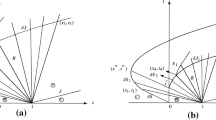This is a study on the initial and boundary value problem of a symmetric hyperbolic system which is related to the conduction of heat in solids at low temperatures. The nonlinear system consists of a conservation equation for the energy density e and a balance equation for the heat flux \(Q_i\), where e and \(Q_i\) are the four basic fields of the theory. The initial and boundary value problem that uses exclusively prescribed boundary data for the energy density e is solved by a new kinetic approach that was introduced and evaluated by Dreyer and Kunik in [1], [2] and Pertame [3]. This method includes the formation of shock fronts and the broadening of heat pulses. These effects cannot be observed in the linearized theory, as it is described in [4].
The kinetic representations of the initial and boundary value problem reveal a peculiar phenomenon. To the solution there contribute integrals containing the initial fields \(e_0 (x), Q_0 (x)\) as well as integrals that need knowledge on energy and heat flux at a boundary. However, only one of these quantities can be controlled in an experiment. When this ambiguity is removed by continuity conditions, it turns out that after some very short time the energy density and heat flux are related to the initial data according to the Rankine Hugoniot relation.
Similar content being viewed by others
Author information
Authors and Affiliations
Additional information
Received October 6, 1998
Rights and permissions
About this article
Cite this article
Dreyer, W., Kunik, M. Initial and boundary value problems of hyperbolic heat conduction. Continuum Mech Thermodyn 11, 227–245 (1999). https://doi.org/10.1007/s001610050113
Issue Date:
DOI: https://doi.org/10.1007/s001610050113



